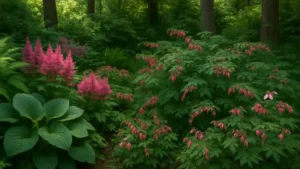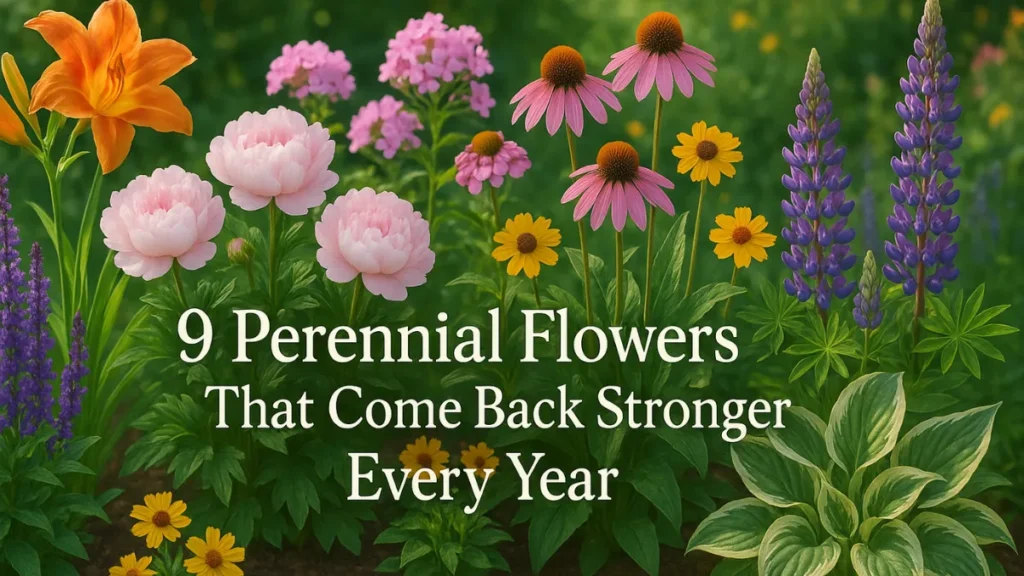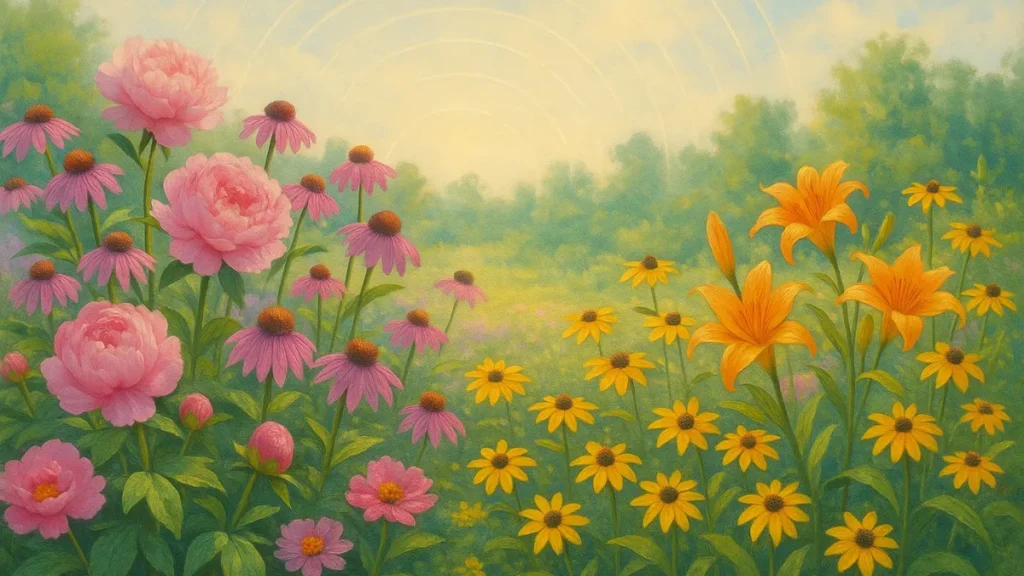Creating a vibrant, colorful garden doesn’t require full sun. Many stunning perennial flowers thrive in shady spaces, bringing life, texture, and long-lasting blooms to even the darkest corners of your yard. Whether you’re working with a woodland area, a shaded border, or a garden tucked beneath large trees, the right plants can transform your landscape into a lush, blooming retreat. In this guide, we’ll introduce you to the top 10 perennial flowers for shade, each selected for their beauty, resilience, and ability to flourish without direct sunlight.
From the early-blooming hellebore to the dramatic spikes of bugbane, these plants offer a range of colors, heights, and textures perfect for every shady garden design. If you’re ready to turn your shaded spaces into standout features, these dependable perennials will give you long-term beauty with minimal upkeep. Let’s dive into the best choices for shaded garden success.
Hellebore (Helleborus spp.)
Hellebores are among the earliest bloomers in the perennial world, often flowering in late winter to early spring, even when snow is still on the ground. These hardy shade-lovers are prized for their nodding, rose-like flowers and attractive leathery foliage. Hellebores come in a wide range of colors, including white, pink, burgundy, green, and even speckled varieties. Native to Europe and parts of Asia, hellebores are deer-resistant and drought-tolerant once established, making them ideal for low-maintenance shady gardens.
They thrive in rich, well-drained soil with plenty of organic matter and do particularly well in woodland settings. Gardeners often use hellebores in mixed shade borders or as groundcovers beneath deciduous trees. Their long blooming period, sometimes lasting several months, and evergreen foliage provide year-round interest. While all parts of the plant are toxic if ingested, hellebores are generally safe to grow and pose little risk with standard handling. They are a top choice for bringing elegance and early color to shaded spots.
Columbine (Aquilegia spp.)
Columbine is a charming and delicate-looking perennial that thrives in partial shade, especially in woodland gardens or along shaded borders. Known for its unique, spurred flowers, columbine attracts hummingbirds and bees, making it not just a visual delight but also a boon for pollinators. The flowers come in a wide range of colors including blues, purples, reds, and yellows, often in two-tone combinations that add visual complexity. Columbine typically blooms in late spring to early summer and pairs well with other shade-loving perennials such as ferns and hostas.
Native species, such as Aquilegia canadensis, are particularly well-suited to North American gardens and are quite hardy. These plants prefer well-drained soil and can tolerate dry conditions once established, although they benefit from occasional watering during prolonged dry spells. Their airy foliage adds texture even after the bloom period has ended. Columbine self-seeds readily, so while each plant may live a few years, they often reappear naturally in gardens, sustaining their presence over time.
Carolina Allspice (Calycanthus floridus)
Carolina Allspice, also known as sweetshrub or spicebush, is a unique perennial shrub that performs well in shaded areas. Native to the southeastern United States, this plant is celebrated for its aromatic, reddish-brown to maroon flowers that appear in late spring and early summer. The blossoms emit a pleasant, spicy fragrance reminiscent of strawberries, cloves, or bananas, depending on the observer. While technically a shrub, it functions well in perennial borders or as a woodland understory plant due to its moderate size and shade tolerance.
Carolina Allspice thrives in moist, well-drained soil and benefits from the dappled sunlight found under trees or large shrubs. Its attractive, glossy green leaves turn a pleasing yellow in the fall, adding seasonal interest. This low-maintenance plant is relatively pest- and disease-free and can be pruned to maintain its shape and size. It’s a great choice for gardeners seeking both visual and olfactory appeal in shaded garden areas.
Bleeding Heart (Dicentra spectabilis)
Bleeding Heart is a quintessential shade garden favorite, instantly recognizable for its arching stems adorned with heart-shaped pink and white flowers. These blooms appear in spring and continue into early summer, gracefully dangling from stems like delicate pendants. The foliage is soft and fern-like, providing additional texture to shaded garden beds. Bleeding Hearts prefer moist, well-drained soil and thrive best in partial to full shade, particularly in cooler climates.
After the blooming period, the foliage often dies back in mid- to late summer, so it’s best planted among other perennials that will fill in the gaps. Native varieties like Dicentra eximia and Dicentra formosa are also excellent choices for more naturalistic or woodland settings and tend to be more heat-tolerant. Despite their delicate appearance, Bleeding Hearts are surprisingly hardy and deer-resistant. They add a romantic, old-fashioned charm to shaded landscapes and pair beautifully with hostas, ferns, and astilbes.
Black Cohosh (Actaea racemosa)
Black Cohosh, also known as bugbane or black snakeroot, is a tall, stately perennial native to eastern North America. This plant is ideal for the back of a shady border or woodland garden, where its dramatic spires of white, bottlebrush flowers can rise 4 to 6 feet or more. Blooming in midsummer, these fragrant flowers attract a variety of pollinators and create a striking contrast against the dark green, deeply lobed foliage. Black Cohosh prefers rich, consistently moist soil and thrives in partial to full shade.
It is a slow-growing plant but rewards patience with long-lasting beauty and minimal maintenance needs. Traditionally used for medicinal purposes, particularly for women’s health, the plant’s roots have historical significance in herbal medicine. However, it should only be used under professional supervision. Gardeners value Black Cohosh for its architectural form and ability to brighten darker garden areas with its tall white plumes and lush foliage.
Barrenwort (Epimedium spp.)
Barrenwort, also known as bishop’s hat or fairy wings, is a tough yet elegant groundcover that excels in dry shade, a notoriously difficult area for most plants. This low-growing perennial forms clumps of heart-shaped leaves that often emerge in shades of bronze or red before turning green, and many varieties also offer attractive fall color. In early to mid-spring, dainty, spurred flowers in shades of yellow, pink, purple, or white rise above the foliage, adding a whimsical charm.
Barrenwort is deer- and rabbit-resistant and thrives in areas under trees or along shady pathways. It’s exceptionally drought-tolerant once established, making it ideal for xeriscaping in shaded conditions. While it spreads slowly via rhizomes, it remains well-behaved and non-invasive. This perennial is often overlooked but is incredibly useful in creating a cohesive, low-maintenance shade garden. It pairs beautifully with hellebores, ferns, and hostas, creating a rich tapestry of texture and form.
Bugbane (Actaea simplex)
Closely related to Black Cohosh, Bugbane (Actaea simplex) is another excellent choice for shady gardens, especially where height and fragrance are desired. This perennial produces tall, elegant spikes of white to pink-tinged flowers that bloom in late summer to early fall, filling the garden with a sweet, slightly musky fragrance. The foliage is often dark purple or bronze, creating a dramatic backdrop for the flower spikes and providing interest even when the plant is not in bloom.
Bugbane thrives in rich, moist soil and partial to full shade, although it can tolerate some morning sun. It is especially effective when planted in groups or at the back of borders, where its height and texture create a focal point. Because it blooms later in the season, Bugbane adds extended interest to the shade garden when many other perennials have finished flowering. It is deer-resistant and relatively free from pests and diseases, making it a dependable performer in challenging garden conditions.
Indian Pink (Spigelia marilandica)
Indian Pink is a lesser-known yet striking perennial native to the southeastern United States. It thrives in part to full shade and is highly prized for its brilliant, tubular red flowers with yellow interiors that bloom in late spring to early summer. These vibrant flowers are a magnet for hummingbirds and make a bold statement in woodland or shaded borders. Indian Pink typically grows to about 1 to 2 feet tall and prefers moist, well-drained soil with plenty of organic matter.
Though it can be slow to establish, it forms tidy clumps over time and is long-lived with minimal care. Its dark green, lance-shaped foliage provides a lush backdrop to the dramatic flowers, and the plant remains attractive even when not in bloom. Indian Pink is a great companion to ferns, hostas, and other native woodland plants. It is also rarely bothered by deer or pests, making it an easy-care option for shady areas that need a pop of color.
Hardy Begonia (Begonia grandis)
Hardy Begonia is one of the few species of begonias that can survive outdoors year-round in temperate climates. Native to East Asia, it features attractive heart-shaped leaves with red undersides and produces delicate, pendulous pink or white flowers from mid-summer into fall. This perennial thrives in partial to full shade and prefers moist, well-drained soil rich in organic matter. Hardy Begonia is particularly useful in shady borders, woodland gardens, or even containers placed in shaded areas.
Its late bloom time makes it a valuable addition for extending color in the shade garden. The plant also self-sows gently, creating naturalistic drifts without becoming invasive. While it dies back to the ground in winter, it reliably re-emerges in spring. Hardy Begonia adds a tropical flair to shady gardens and pairs well with hostas, ferns, and other broad-leaved perennials. It is relatively free from pests and diseases, making it a reliable and beautiful choice for shade-loving gardeners.
Astilbe (Astilbe spp.)
Astilbe is a staple in shade gardens due to its feathery, plume-like flowers and finely textured foliage. Blooming from late spring into summer, astilbe offers a wide range of flower colors, including white, pink, red, and lavender. The flowers rise above the foliage on sturdy stalks and attract pollinators like bees and butterflies. Astilbe thrives in partial to full shade and prefers consistently moist soil—making it a great choice for damp, shaded locations such as alongside streams, ponds, or shady borders.
Its foliage remains attractive throughout the growing season, and some varieties even offer bronzed or red-tinged leaves for added interest. Astilbes range in height from 6 inches to over 4 feet, making them versatile for various garden roles, from groundcover to vertical accent. They look especially striking when planted en masse or combined with hostas and ferns. While they require regular watering, particularly during dry spells, astilbes are otherwise low-maintenance and provide dependable color and texture year after year.
Bottom Line
Shaded gardens don’t have to be dull or lifeless. With the right selection of shade-loving perennials, you can create a lush, colorful, and low-maintenance landscape that thrives year after year. The ten perennials featured in this list—such as Hellebore, Astilbe, and Black Cohosh—not only tolerate low-light conditions but bring seasonal interest and unique textures to your garden.
Whether you’re a seasoned gardener or just getting started, these plants offer dependable growth and natural beauty. Embrace your shady spaces with confidence and turn them into blooming highlights of your outdoor living space.
FAQs
What are the best flowers for full shade?
Some of the best flowers for full shade include Hellebore, Bleeding Heart, Astilbe, and Barrenwort. These thrive with minimal sunlight and add color and texture to shady areas.
Do perennial shade flowers come back every year?
Yes, perennial shade flowers like those on this list return year after year, often growing stronger with time as they establish deeper root systems.
How can I improve my soil for shade perennials?
Adding compost or organic matter improves drainage and soil fertility, which is especially helpful in shaded areas that may retain moisture.
Can I grow shade-loving perennials in containers?
Absolutely. Many shade perennials like Hardy Begonia and Columbine grow well in containers, provided they have rich soil and consistent moisture.



